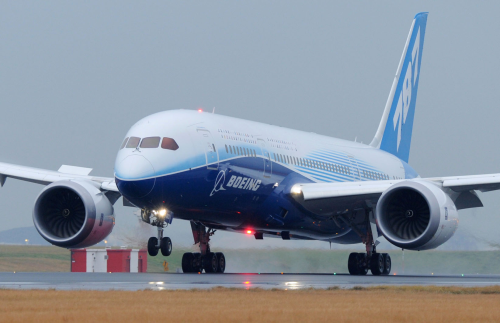
Since the Boeing 787 Dreamliner entered service in October 2011, passenger response to the airliner has been generally positive. Meanwhile, however, there have been technical concerns – a brakes problem, oil and fuel leaks in the engines, cracked windscreen, electronic and software faults etc. These prompted the Federal Aviation Adminstration (FAA) to announce, on January 11th, a review of the aircraft’s critical systems (see FAA review for Boeing 787 – updated 16 January).
Then came a shock setback that resulted in a complete grounding of the fleet of 24 aircraft so far delivered to Japan, subsequently followed by an FAA-imposed grounding of all US-delivered 787s also.
'All-electric' strategy
Part of Boeing’s radical agenda for its new airliner was to adopt an ‘all-electric’ architecture in which control surfaces and other systems that have traditionally been operated hydraulically are now actuated electrically.
Powerful batteries are needed, not least to start the auxiliary power unit (APU), the small engine in the tail of the aircraft that provides power when the main engines, and the attached generators, are not running and ground power is not available. For these batteries Boeing adopted an advanced lithium (Li)-ion chemistry, lithium-cobalt oxide, chosen for its high energy density. But, despite extensive development and testing before the first aircraft ever flew, there have been instances of these batteries over-heating and even reportedly catching fire.
A single reported fire occurred on 7th January this year on a JAL B787 when it was on the ground at Boston Airport, USA. This was followed eight days later by a battery overheat incident on an ANA B787 in flight. When smoke was detected inside the aircraft, the pilots elected to make a precautionary landing and an emergency evacuation followed. In this second incident a short circuit had occurred in one of the battery’s eight cells and the ensuing thermal chain reaction had caused the smoke and the conditions for a fire.
The possibility of a fire aboard an aircraft is an absolute ‘no no’ and after this second significant event the FAA had little choice but to order the six B787s delivered in the US to be grounded. The Japanese had already grounded theirs and authorities in Chile and India followed the US decision.
The turn of events was an embarrassment given that the FAA had previously certified the Dreamliner and its systems as airworthy.
Deliveries of new aircraft were halted, though production has continued.
| It is well known that lithium-ion batteries are sensitive to charge/discharge conditions and can overheat if certain parameters are exceeded. |
So far (as of early April) Boeing, Rose Electronics/Kokam responsible for the battery, the FAA and the National Transportation Safety Board in the US plus Japan’s Transport Safety Board remain unclear as to the precise cause of the problem.
It is well known that lithium-ion batteries are sensitive to charge/discharge conditions and can overheat if certain parameters are exceeded. (Some owners of lap-top computers and mobile phones have experienced this and an air freighter crashed following suspected thermal runaway and a fire in a cargo of Li-ion batteries). In a large multi-cellular battery, if over-heating should spread from an initial faulty cell, cascading to adjacent cells, the ensuing thermal runaway is hard to arrest and can lead to a fire which is difficult to extinguish. Boeing and its contractors thought they had prevented all possibility of this happening with careful system design, but evidently they were mistaken.
The proposed fix
Boeing has now proposed a fix that involves increasing inter-cell spacing, inserting ceramic plates between the cells, providing a stainless steel battery enclosure and adding a venting system to prevent smoke reaching the cabin.
| In March, almost two months after the grounding decision, the FAA granted Boeing clearance to flight test the proposed redesign on two of the flight test aircraft, following extensive tests on the ground. |
In March, almost two months after the grounding decision, the FAA granted Boeing clearance to flight test the proposed redesign on two of the flight test aircraft, following extensive tests on the ground. Should those tests prove successful in leading to recertification, Boeing will have to modify main and APU battery installations on the 50 or so aircraft already delivered, a task estimated to take four to five days per aircraft. The changes would also become part of a revised production standard.
Critics point out that the remedial measures may prevent cascading thermal runway and fires, but do not address the root cause of the problem. By early April that cause remained a mystery and investigations were continuing.
Boeing has always stood by its battery choices despite some experts suggesting that it might have to change to an alternative Li-ion chemistry or, in the extreme, revert to a previous battery generation, nickel-cadmium (NiCad). (Ironically, NiCad batteries themselves were involved in thermal runaway events a decade ago when they were coming into aircraft use.) This would require a redesign and re-certification effort as well as incurring weight and space penalties. ♦




